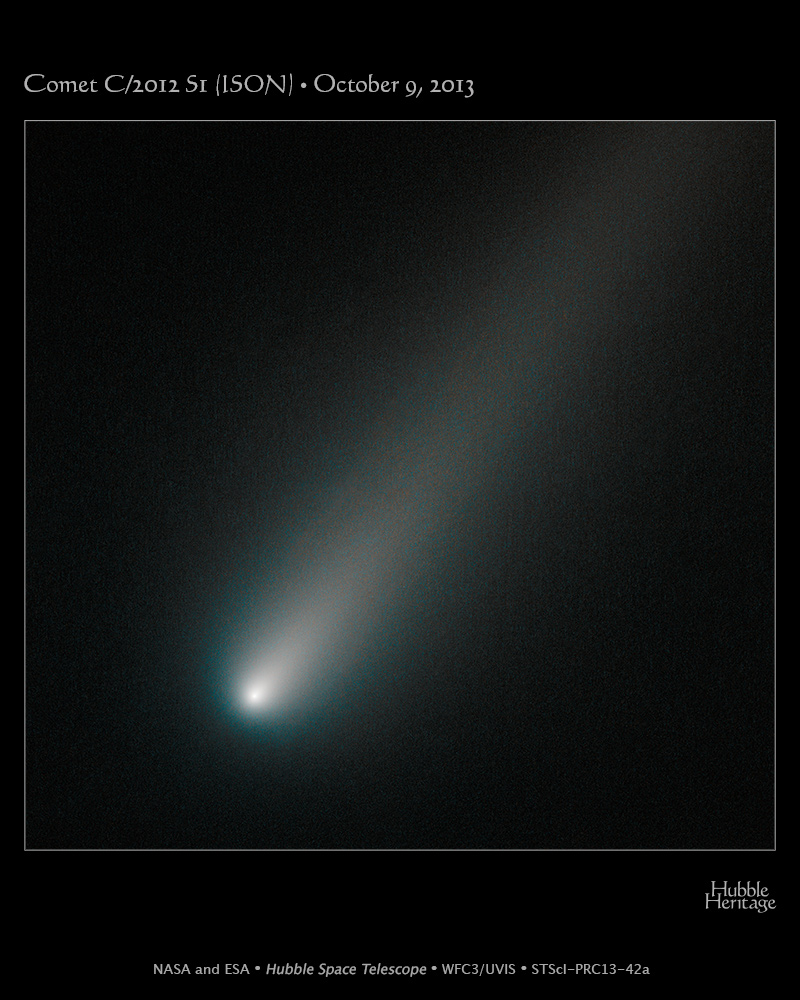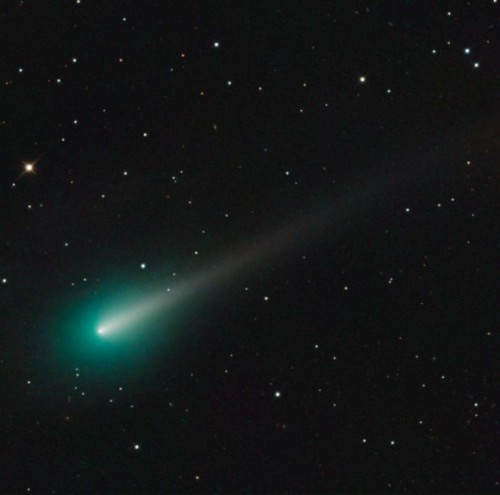
Comet ISON, identified as C/2012 S1, is making its first visit to the inner Solar System, and in just over a month it will dive to within one million miles of the Sun’s surface. There has been much speculation since ISON’s discovery in 2012 that it could become one of the most fantastic comets any of us will see in our lifetimes—or it could fizzle into nothing and be no more “spectacular” than comet Pan-STARRS was this past spring (barely visible to the naked eye, if at all). But, if recent images from NASA’s Hubble Space Telescope are any indication, ISON appears to be in tact, which is a good sign that it will survive its brush with the Sun in late November.
A new image of ISON, captured by NASA’s Hubble Space Telescope on Oct. 9, 2013, clearly shows that the comet has not begun to disintegrate as it heats up, which had been predicted by some scientists as it gets closer to the Sun. Nobody really knows yet how big ISON’s icy nucleus is—estimates range from over 1,000 feet to over 1 mile in diameter—but if the comet’s solid nucleus was falling apart, then Hubble likely would see the broken fragments.

“If ISON’s nucleus is much bigger than 0.5 km, it will probably survive its Thanksgiving Day brush with the Sun,” said astronomer Carey Lisse of the Johns Hopkins University Applied Physics Lab. “It could turn into one of the most spectacular comets in many years.”
The comet may not be breaking apart yet, but recent images show a greenish hue to the comet’s color, indicating solar heating is already causing frozen water on ISON to vaporize. Additionally, the “head” of the comet is ” symmetric and smooth” according to NASA, which again indicates that ISON is still in tact as it plummets toward the Sun at over 80,000 mph—and it’s still accelerating. At perihelion, the comet’s closest approach to the Sun, it will pass just 720,000 miles over the surface, with a velocity of over 800,000 mph. If ISON survives its suicidal solar encounter, it could put on a spectacular show in our night skies over the holiday season, assuming it can withstand the 5,000+ degree temperatures and incredible gravitational forces it will encounter. The comet, however, poses no threat to Earth, as its closest approach to our world happens Dec. 26 at a distance of about 40 million miles.
“We really do not know what comet ISON is going to do when it gets near the Sun. Its passage through the solar corona is going to expose it to some really pretty insane solar radiation bombardment that will begin to furiously boil its surface away,” wrote astronomer Karl Battams on the ISON Observing Campaign website. “In addition to that, the gravitational tug of the Sun will pull and stretch the comet, testing its structural integrity to the absolute maximum. Either, or both, of these factors could lead to its demise at any point in the days surrounding perihelion.”
Battams adds,”What we can say for certain, right now, is that comet ISON is doing just fine! It continues to behave like a fairly typical, if somewhat smaller-than-average, Oort Cloud comet. It has given no indication that it has fragmented and while such an event can never be ruled out, we see no evidence or hint that the comet is in any imminent danger of doing so. Any reports to the contrary are just speculation.”
Video Credit: NASA’s Goddard Space Flight Center Scientific Visualization Studio
Astronomers and scientists from around the world have been watching closely because, being that ISON has never visited the Sun, the pristine matter from the earliest days of the Solar System’s formation still coats the comet’s surface. ISON’s visit is unique because no “first time visitor” has entered the inner Solar System at any point in recorded history, which presents a rare research opportunity for researchers to take advantage of the knowledge hidden in this time capsule from when the Solar System first formed. All of those secrets about the formation of the Solar System that are hidden within the comet are expected to explode into space (literally) as the comet heats up on its approach to the Sun. An unprecedented number of spacecraft (16 in all), as well as astronauts aboard the International Space Station and astronomers around the world, are working together to observe the comet as it passes through our neighborhood.
On Oct. 1, 2013, NASA attempted to photograph the comet from another world—Mars. Various spacecraft on the surface and in orbit around the Red Planet had ringside seats to Comet ISON’s close pass, some 6.7 million miles from Mars—about six times closer than it will ever come to Earth. The raw images captured by both NASA surface rovers Opportunity and Curiosity do not show the comet (it is likely that ISON is lost in the compression), but the orbiting Mars Reconnaissance Orbiter (MRO) did capture ISON with its High Resolution Imaging Science Experiment (HiRISE) camera.

“These images show a 256 x 256 pixel patch of sky at the range to the comet of 8 million miles and when the solar phase angle is 47 degrees,” wrote HiRISE researchers Alan Delamere and Alfred McEwen on the HiRISE website. “Based on preliminary analysis of the data, the comet appears to be at the low end of the range of brightness predictions for the observation. As a result, the image isn’t visually pleasing but low coma activity is best for constraining the size of the nucleus. This image has a scale of approximately 8 miles (13.3 km) per pixel, larger than the comet, but the size of the nucleus can be estimated based on the typical brightness of other comet nuclei. As the comet gets closer to the sun, its brightness will increase to Earth-based observers and the comet may also become intrinsically brighter as the stronger sunlight volatilizes the comet’s ices.”
As of Oct. 17, 2013, comet ISON is 196 million miles from the Sun, pushing through space at over 80,000 mph toward a Thanksgiving meeting with our star. Only time will tell whether or not ISON lives up to the hype and survives its suicidal solar encounter, but if it does there will be a new sight to gaze at in the night sky during the holidays.
Want to keep up-to-date with all things space? Be sure to “Like” AmericaSpace on Facebook and follow us on Twitter: @AmericaSpace




Correction to headline – Intact